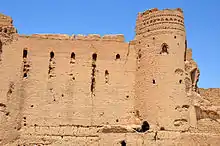Fahraj, Yazd
Fahraj (Persian: فهرج, also Romanized as Fahrej; also known as Fahruj and Faraj)[1] is a village in Fahraj Rural District, in the Central District of Yazd County, Yazd Province, Iran. At the 2006 census, its population was 2,694, in 697 families.[2] Located 30 km southeast of Yazd on the road to Bafq, at the foothill of Chalta mountain, Fahraj lies in an arid region on the edge of the desert and relies on qanats and deep wells for its water supply. Its population consists mainly of Persian-speaking Shi'ites.[3]
Fahraj
فهرج | |
|---|---|
village | |
 Fahraj | |
| Coordinates: 31°45′47″N 54°34′46″E | |
| Country | |
| Province | Yazd |
| County | Yazd |
| Bakhsh | Central |
| Rural District | Fahraj |
| Population (2006) | |
| • Total | 2,694 |
| Time zone | UTC+3:30 (IRST) |
| • Summer (DST) | UTC+4:30 (IRDT) |

History
In the Tarikh-e Yazd, Ja'far ibn Mohammad Ja'fari attributed Fahraj's founding to the Sasanian king Kavad I. As Bahra, the 10th-century geographers Estakhri and al-Moqaddasi listed Fahraj as one of the main towns in the province of Yazd, along with Meybod and Na'in. Like the other two, Fahraj was described as possessing a jameh mosque. Later, Abu'l-Fida gave the geographical coordinates of Fahraj, something he only did for places he considered important, indicating the continued significance of Fahraj at this time.[3]
Fahraj was the scene of an episode during Muslim conquest of Persia. The army of the caliph Umar I, chasing the Sasanian emperor Yazdegerd III, came to Fahraj, where they called upon the town's Zorastrian inhabitants to convert to Islam. The people of Fahraj resisted, along with those of nearby Khovaydak and Faraftar, and they fought back against the Muslim army. A number of the companions of Muhammad, as well as members of the following generation, were killed. They came to be known as the šohadā-ye Fahraj, or "the martyrs of Fahraj", and mausoleums said to belong to them still exist at Abadi-ye Shohada, 2 km outside of Fahraj.[3]
Mosque
The jameh mosque of Fahraj, located in the center of town, is one of the oldest extant mosques in Iran. It is made of sun-dried bricks, with the façade coated in sim-gel (a mixture of sand, clay, and chopped straw, gel-rig, and plaster bracing. The minaret, built in the 10th or 11th century, is made of smaller bricks. The eastern wall has stucco reliefs that, along with other decorative elements, resemble Sasanian art. In times of upheaval, people would store their valuables in hiding places in the mosque to protect them from thieves or raiders.[3]
References
- Fahraj can be found at GEOnet Names Server, at this link, by opening the Advanced Search box, entering "-3062553" in the "Unique Feature Id" form, and clicking on "Search Database".
- "Census of the Islamic Republic of Iran, 1385 (2006)". Islamic Republic of Iran. Archived from the original (Excel) on 2011-11-11.
- Langarudi, Rezazadeh. "FAHRAJ)". Encyclopaedia Iranica. Retrieved 25 May 2020.